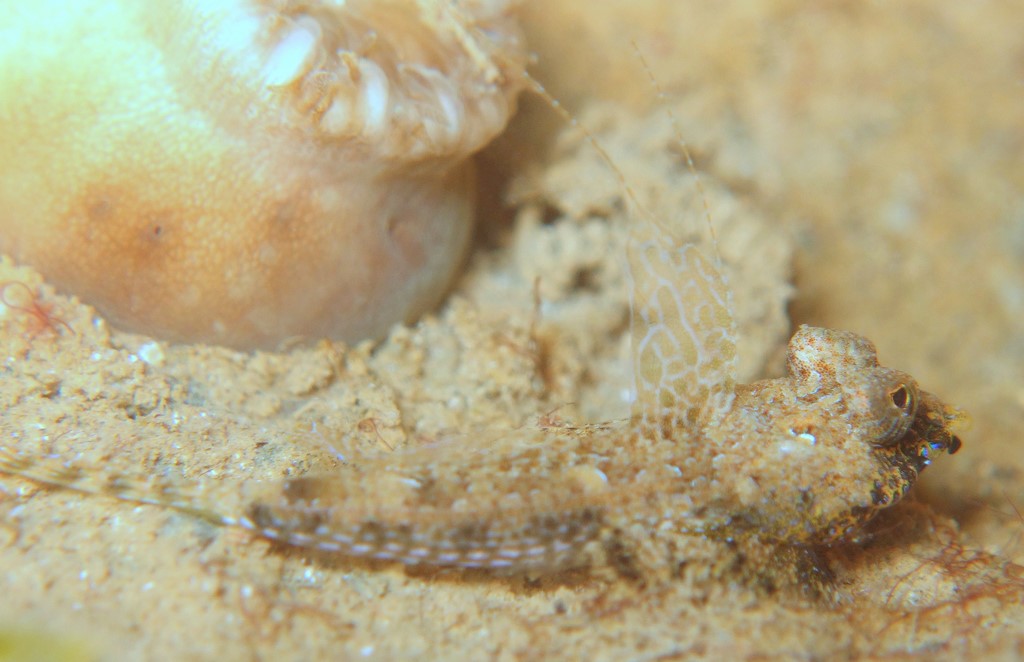CALLIONYMUS KEELEYI - (FOWLER, 1941)
Picture courtesy of: Alain Daoulas
Actinopterygii (Gigaclass) > Actinopteri (Class) > Teleostei (Subclass) > Syngnathiformes (Order) > Callionymoidei (Suborder) > Callionymidae (Family) > Callionymus (Genus)
Dragonnet de Keeley, Keeley’s dragonet,
synonyme
Repomucenus keeleyi (Fowler, 1941)
------------------------
Description
Dorsal spines (total): 5; Dorsal soft rays (total): 9; Two first spines prolonged into long filaments, first longer or 1.3/5 in fish without caudal, first ray: 1.1/5 in head; Anal spines: 1; Anal soft rays: 9, first ray: 2.3/4; Least depth of caudal peduncle: 4; Pectoral fin rays: 19, 1.1/6 in fish without caudal; Pelvic fin rays: I, 5, fin: 3.1/3 in fish without caudal; Caudal: 1.3/4. Anal papilla conic, simple, depressed, long as pupil. Lateral line complete, high along side of back, simple, and extends out on caudal base. Parietal region smooth. Depth: 7.4/5; Head: 3.4/5, long as wide. Snout: 2.2/5 in head; Eye: 3.1/8, 1.1/3 in snout; Maxillary concealed; Mouth cleft reaches halfway to eye, lower jaw little shorter; Teeth villiform, fine, conic, simple, in rather wide short bands in jaws, form narrow band along each side of jaw; Mandible shallow, rami not elevated inside mouth; Interorbital narrow bony ridge separating large close set eyes. Preopercular spine: 3/4 of eye, ends in small slightly recurved denticle, four more mostly larger ones along inner edge, and small basal denticle in front pointing forward. Max. length: 9.0 cm TL. Depth range: 2 - 70 m.
Actinopterygii (Gigaclass) > Actinopteri (Class) > Teleostei (Subclass) > Syngnathiformes (Order) > Callionymoidei (Suborder) > Callionymidae (Family) > Callionymus (Genus)
Dragonnet de Keeley, Keeley’s dragonet,
synonyme
Repomucenus keeleyi (Fowler, 1941)
------------------------
Description
Dorsal spines (total): 5; Dorsal soft rays (total): 9; Two first spines prolonged into long filaments, first longer or 1.3/5 in fish without caudal, first ray: 1.1/5 in head; Anal spines: 1; Anal soft rays: 9, first ray: 2.3/4; Least depth of caudal peduncle: 4; Pectoral fin rays: 19, 1.1/6 in fish without caudal; Pelvic fin rays: I, 5, fin: 3.1/3 in fish without caudal; Caudal: 1.3/4. Anal papilla conic, simple, depressed, long as pupil. Lateral line complete, high along side of back, simple, and extends out on caudal base. Parietal region smooth. Depth: 7.4/5; Head: 3.4/5, long as wide. Snout: 2.2/5 in head; Eye: 3.1/8, 1.1/3 in snout; Maxillary concealed; Mouth cleft reaches halfway to eye, lower jaw little shorter; Teeth villiform, fine, conic, simple, in rather wide short bands in jaws, form narrow band along each side of jaw; Mandible shallow, rami not elevated inside mouth; Interorbital narrow bony ridge separating large close set eyes. Preopercular spine: 3/4 of eye, ends in small slightly recurved denticle, four more mostly larger ones along inner edge, and small basal denticle in front pointing forward. Max. length: 9.0 cm TL. Depth range: 2 - 70 m.
Color
In alcohol, back and upper surfaces brown, variegated with darker and paler marblings. Eight diffuse or obscure median darker blotches on back. Sides of head and body with more defined and contrasted dark spots on sides. Eyes gray, with silvery tints and darker markings. All under surfaces of body immaculate whitish. First dorsal dark gray to gray-black, especially on second and third membranes; some paler longitudinal lines on first two membranes. Second dorsal transparent, with scattered dark spots or specks on rays. Anal pale, dark to blackish brown m.arginally. Caudal whitish, gray terminally, and with a dozen irregular transverse rows of dark to kackish spots. Pectoral whitish, with numerous small, irregular, blackish-brown spots above. Ventral pale to whitish basally, dark to blackish brown termuially, and inner half of fin with connecting membrane marked with small dark to blackish dots.
Etymology
Callionymus: from Greek, kallos = good, beautiful + from Greek suffix, -onym = name, word, with a better name. Callionymus (Linnaeus, 1758) is also the latinization of kallionymos, Aristotle’s name for stargazers (Uranoscopidae), which Linnaeus apparently confused with dragonets.
keeleyi: named for Frank J. Keeley, of the department of mineralogy, Academy of Natural Sciences of Philadelphia.
Original description: Callionymus keeleyi Fowler, 1941 - Type locality: Cebu, Philippines.
Distribution
Western Pacific: Philippines, Papua New Guinea, Australia, New Caledonia.
Biology
Juveniles are found in sandy bottom.
In alcohol, back and upper surfaces brown, variegated with darker and paler marblings. Eight diffuse or obscure median darker blotches on back. Sides of head and body with more defined and contrasted dark spots on sides. Eyes gray, with silvery tints and darker markings. All under surfaces of body immaculate whitish. First dorsal dark gray to gray-black, especially on second and third membranes; some paler longitudinal lines on first two membranes. Second dorsal transparent, with scattered dark spots or specks on rays. Anal pale, dark to blackish brown m.arginally. Caudal whitish, gray terminally, and with a dozen irregular transverse rows of dark to kackish spots. Pectoral whitish, with numerous small, irregular, blackish-brown spots above. Ventral pale to whitish basally, dark to blackish brown termuially, and inner half of fin with connecting membrane marked with small dark to blackish dots.
Etymology
Callionymus: from Greek, kallos = good, beautiful + from Greek suffix, -onym = name, word, with a better name. Callionymus (Linnaeus, 1758) is also the latinization of kallionymos, Aristotle’s name for stargazers (Uranoscopidae), which Linnaeus apparently confused with dragonets.
keeleyi: named for Frank J. Keeley, of the department of mineralogy, Academy of Natural Sciences of Philadelphia.
Original description: Callionymus keeleyi Fowler, 1941 - Type locality: Cebu, Philippines.
Distribution
Western Pacific: Philippines, Papua New Guinea, Australia, New Caledonia.
Biology
Juveniles are found in sandy bottom.
Last update: 22, May 2023
